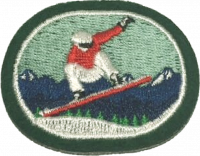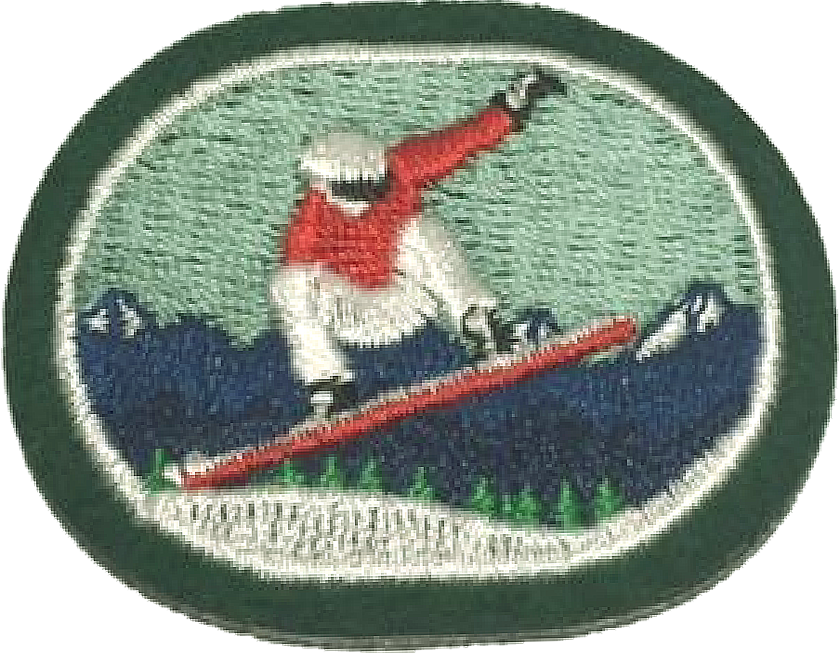Difference between revisions of "AY Honors/Snowboarding/Answer Key/es"
From Pathfinder Wiki
< AY Honors | SnowboardingAY Honors/Snowboarding/Answer Key/es
(Created page with "{{clear}}") |
|||
| (16 intermediate revisions by 2 users not shown) | |||
| Line 1: | Line 1: | ||
| − | + | {{HonorSubpage}} | |
| − | |||
| − | |||
| − | {{ | ||
| − | |||
| − | |||
| − | |||
| − | |||
| − | |||
| − | |||
| − | |||
| − | |||
| − | |||
| − | |||
| − | |||
| − | |||
<section begin="Body" /> | <section begin="Body" /> | ||
{{ansreq|page={{#titleparts:{{PAGENAME}}|2|1}}|num=1}} | {{ansreq|page={{#titleparts:{{PAGENAME}}|2|1}}|num=1}} | ||
<noinclude></noinclude> | <noinclude></noinclude> | ||
| − | <!-- 1. | + | <!-- 1. En pocas palabras, describir el significado del término «Snowboard». --> |
<noinclude></noinclude> | <noinclude></noinclude> | ||
| Line 24: | Line 9: | ||
{{ansreq|page={{#titleparts:{{PAGENAME}}|2|1}}|num=2}} | {{ansreq|page={{#titleparts:{{PAGENAME}}|2|1}}|num=2}} | ||
<noinclude></noinclude> | <noinclude></noinclude> | ||
| − | <!-- 2. | + | <!-- 2. Definir y explicar cada nivel de las clasificaciones de dificultad de las pistas de esquí en las que se encuentra para hacer snowboard; por ejemplo, Australia, Nueva Zelanda y Norteamérica: --> |
<noinclude></noinclude> | <noinclude></noinclude> | ||
| Line 61: | Line 46: | ||
{{clear}} | {{clear}} | ||
| − | + | {{clear}} | |
| − | |||
| − | |||
| − | |||
| − | |||
| − | |||
| − | |||
| − | |||
| − | |||
| − | |||
| − | |||
| − | |||
| − | |||
| − | |||
| − | |||
| − | |||
| − | |||
| − | |||
| − | |||
| − | |||
| − | |||
| − | |||
| − | |||
| − | |||
| − | |||
| − | |||
| − | |||
| − | |||
| − | |||
| − | |||
| − | + | {{clear}} | |
| − | |||
| − | |||
| − | |||
| − | |||
| − | |||
| − | |||
| − | |||
| − | |||
<noinclude></noinclude> | <noinclude></noinclude> | ||
| Line 107: | Line 55: | ||
{{ansreq|page={{#titleparts:{{PAGENAME}}|2|1}}|num=3}} | {{ansreq|page={{#titleparts:{{PAGENAME}}|2|1}}|num=3}} | ||
<noinclude></noinclude> | <noinclude></noinclude> | ||
| − | <!-- 3. | + | <!-- 3. Hacer una lista y explicar el Código de responsabilidad alpino australiano (o equivalente) y demostrar su cumplimiento del código a través de los requisitos 7 y 8. --> |
| − | + | {{clear}} | |
| − | |||
| − | |||
| − | |||
| − | |||
| − | |||
| − | |||
| − | |||
| − | |||
| − | |||
| − | |||
| − | + | {{clear}} | |
<noinclude></noinclude> | <noinclude></noinclude> | ||
| Line 127: | Line 65: | ||
{{ansreq|page={{#titleparts:{{PAGENAME}}|2|1}}|num=4}} | {{ansreq|page={{#titleparts:{{PAGENAME}}|2|1}}|num=4}} | ||
<noinclude></noinclude> | <noinclude></noinclude> | ||
| − | <!-- 4. | + | <!-- 4. Definir los siguientes términos de snowboard: --> |
<noinclude></noinclude> | <noinclude></noinclude> | ||
| Line 163: | Line 101: | ||
{{ansreq|page={{#titleparts:{{PAGENAME}}|2|1}}|num=5}} | {{ansreq|page={{#titleparts:{{PAGENAME}}|2|1}}|num=5}} | ||
<noinclude></noinclude> | <noinclude></noinclude> | ||
| − | <!-- 5. | + | <!-- 5. Describir brevemente el siguiente equipo esencial para el snowboard y cómo mantenerlo en buenas condicionesː --> |
<noinclude></noinclude> | <noinclude></noinclude> | ||
| Line 204: | Line 142: | ||
{{ansreq|page={{#titleparts:{{PAGENAME}}|2|1}}|num=6}} | {{ansreq|page={{#titleparts:{{PAGENAME}}|2|1}}|num=6}} | ||
<noinclude></noinclude> | <noinclude></noinclude> | ||
| − | <!-- 6. | + | <!-- 6. Memorizar un pasaje de la Biblia que menciona la palabra «nieve». En pocas palabras, comentar lo que significa el pasaje para ti. --> |
<noinclude></noinclude> | <noinclude></noinclude> | ||
| Line 210: | Line 148: | ||
{{ansreq|page={{#titleparts:{{PAGENAME}}|2|1}}|num=7}} | {{ansreq|page={{#titleparts:{{PAGENAME}}|2|1}}|num=7}} | ||
<noinclude></noinclude> | <noinclude></noinclude> | ||
| − | <!-- 7. | + | <!-- 7. Saber y demostrar cómo subirse y bajarse de manera segura en un telesilla. --> |
<noinclude></noinclude> | <noinclude></noinclude> | ||
| Line 216: | Line 154: | ||
{{ansreq|page={{#titleparts:{{PAGENAME}}|2|1}}|num=8}} | {{ansreq|page={{#titleparts:{{PAGENAME}}|2|1}}|num=8}} | ||
<noinclude></noinclude> | <noinclude></noinclude> | ||
| − | <!-- 8. | + | <!-- 8. Demostrar su habilidad para hacer snowboard, en buena forma, en numerosas pendientes de grado intermedio. Demostrar competencia en: --> |
<noinclude></noinclude> | <noinclude></noinclude> | ||
| Line 236: | Line 174: | ||
{{CloseReq}} <!-- 8 --> | {{CloseReq}} <!-- 8 --> | ||
<noinclude></noinclude> | <noinclude></noinclude> | ||
| − | == | + | ==Referencias== |
| − | [ | + | * (Solo disponible en inglés) [https://pathfinders.adventistchurch.com/snowboarding-1/ Recursos de la División del Pacifico Sur] |
| + | |||
<noinclude></noinclude> | <noinclude></noinclude> | ||
| − | + | {{CloseHonorPage}} | |
Latest revision as of 14:54, 29 December 2021
Snowboarding
Nivel de destreza
2
Año
2019
Version
17.11.2024
Autoridad de aprobación
División del Pacífico Sur
1
En pocas palabras, describir el significado del término «Snowboard».
2
Definir y explicar cada nivel de las clasificaciones de dificultad de las pistas de esquí en las que se encuentra para hacer snowboard; por ejemplo, Australia, Nueva Zelanda y Norteamérica:
2a
Círculo verde
2b
Cuadro azul
2c
Diamante negro
2d
Doble diamante negro
2e
Variaciones
2f
Snowpark
3
Hacer una lista y explicar el Código de responsabilidad alpino australiano (o equivalente) y demostrar su cumplimiento del código a través de los requisitos 7 y 8.
4
Definir los siguientes términos de snowboard:
4a
Pista
4b
Fuera de pista
4c
Posturas: regular y goofy
4d
Lado de los dedos
4e
Lado de los talones
4f
Cambiar (switch)
5
Describir brevemente el siguiente equipo esencial para el snowboard y cómo mantenerlo en buenas condicionesː
5a
Snowboard
5b
Fijaciones
5c
Botas de snowboard
5d
Casco
5e
Muñequeras
5f
Protección de ojos y piel
5g
Ropa adecuada, incluyendo las capas
6
Memorizar un pasaje de la Biblia que menciona la palabra «nieve». En pocas palabras, comentar lo que significa el pasaje para ti.
7
Saber y demostrar cómo subirse y bajarse de manera segura en un telesilla.
8
Demostrar su habilidad para hacer snowboard, en buena forma, en numerosas pendientes de grado intermedio. Demostrar competencia en:
8a
Atravesar usando tanto el lado de los talones como del lado de los dedos.
8b
Cambiar de dirección mientras conduce.
8c
Detenerse con confianza.
Referencias
- (Solo disponible en inglés) Recursos de la División del Pacifico Sur


